air condition FIAT STRADA 2014 Owner handbook (in English)
[x] Cancel search | Manufacturer: FIAT, Model Year: 2014, Model line: STRADA, Model: FIAT STRADA 2014Pages: 187, PDF Size: 8.06 MB
Page 26 of 187
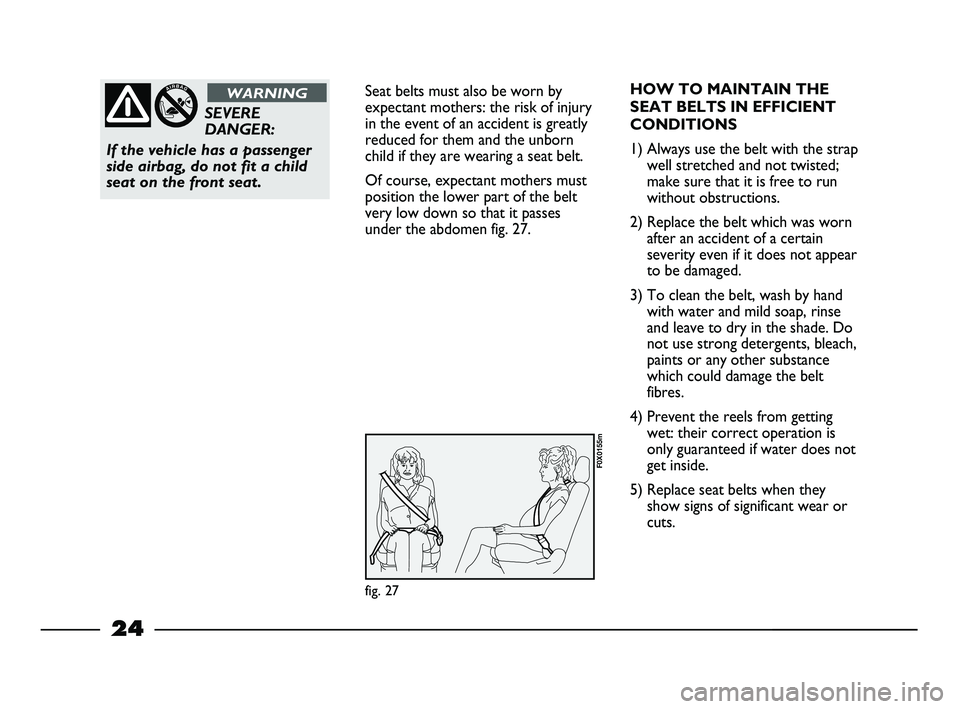
24
Seat belts must also be worn by
expectant mothers: the risk of injury
in the event of an accident is greatly
reduced for them and the unborn
child if they are wearing a seat belt.
Of course, expectant mothers must
position the lower part of the belt
very low down so that it passes
under the abdomen fig. 27.
fig. 27
F0X0155m
HOW TO MAINTAIN THE
SEAT BELTS IN EFFICIENT
CONDITIONS
1) Always use the belt with the strap
well stretched and not twisted;
make sure that it is free to run
without obstructions.
2) Replace the belt which was worn
after an accident of a certain
severity even if it does not appear
to be damaged.
3) To clean the belt, wash by hand
with water and mild soap, rinse
and leave to dry in the shade. Do
not use strong detergents, bleach,
paints or any other substance
which could damage the belt
fibres.
4) Prevent the reels from getting
wet: their correct operation is
only guaranteed if water does not
get inside.
5) Replace seat belts when they
show signs of significant wear or
cuts.
SEVERE
DANGER:
If the vehicle has a passenger
side airbag, do not fit a child
seat on the front seat.
WARNING
007-044 STRADA LUM GB 1ed 9-01-2012 14:49 Pagina 24
Page 59 of 187
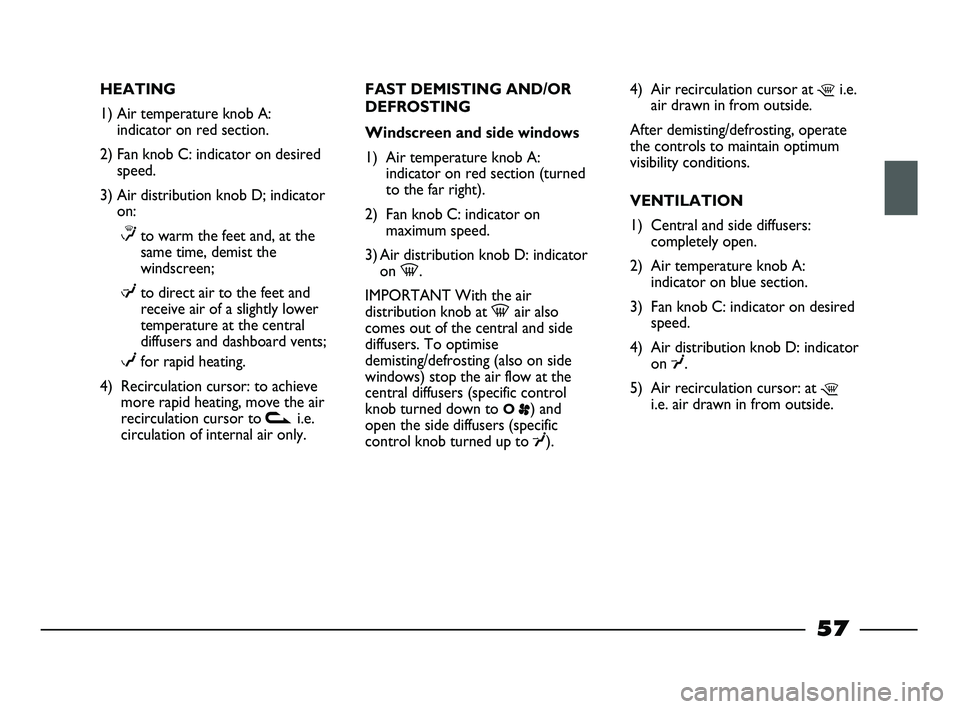
HEATING
1) Air temperature knob A:
indicator on red section.
2) Fan knob C: indicator on desired
speed.
3) Air distribution knob D; indicator
on:
≤to warm the feet and, at the
same time, demist the
windscreen;
μto direct air to the feet and
receive air of a slightly lower
temperature at the central
diffusers and dashboard vents;
wfor rapid heating.
4) Recirculation cursor: to achieve
more rapid heating, move the air
recirculation cursor to vi.e.
circulation of internal air only.FAST DEMISTING AND/OR
DEFROSTING
Windscreen and side windows
1) Air temperature knob A:
indicator on red section (turned
to the far right).
2) Fan knob C: indicator on
maximum speed.
3) Air distribution knob D: indicator
on -.
IMPORTANT With the air
distribution knob at -air also
comes out of the central and side
diffusers. To optimise
demisting/defrosting (also on side
windows) stop the air flow at the
central diffusers (specific control
knob turned down to
O
p) and
open the side diffusers (specific
control knob turned up to
¥).4) Air recirculation cursor at
¶i.e.
air drawn in from outside.
After demisting/defrosting, operate
the controls to maintain optimum
visibility conditions.
VENTILATION
1) Central and side diffusers:
completely open.
2) Air temperature knob A:
indicator on blue section.
3) Fan knob C: indicator on desired
speed.
4) Air distribution knob D: indicator
on
¥.
5) Air recirculation cursor: at
¶i.e. air drawn in from outside.
57
045-094 STRADA LUM GB 1ed 23-01-2012 9:10 Pagina 57
Page 60 of 187
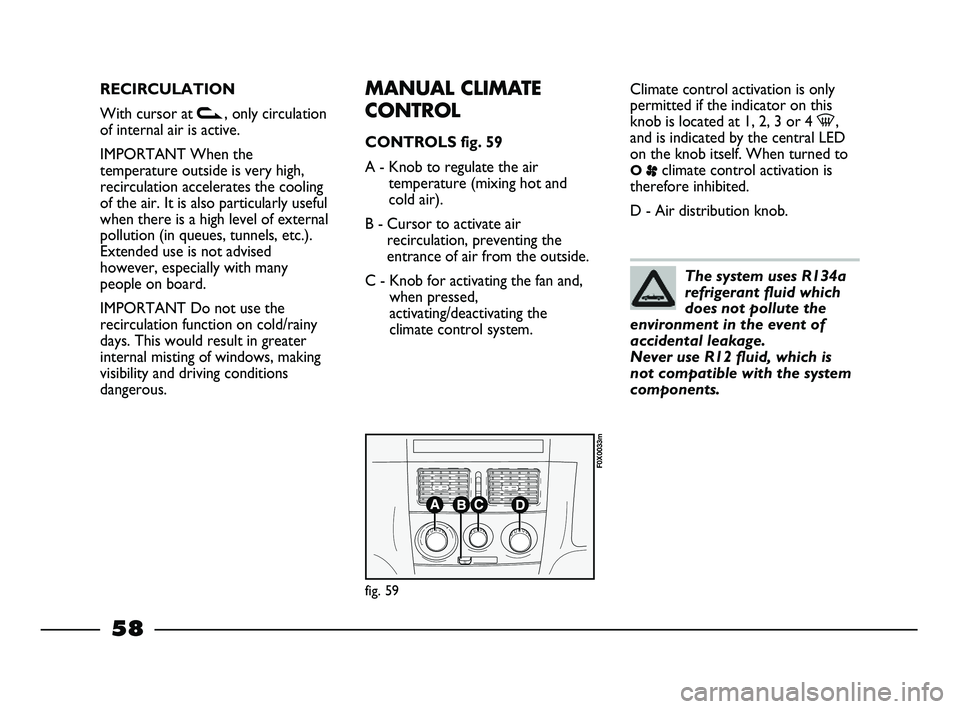
RECIRCULATION
With cursor at v, only circulation
of internal air is active.
IMPORTANT When the
temperature outside is very high,
recirculation accelerates the cooling
of the air. It is also particularly useful
when there is a high level of external
pollution (in queues, tunnels, etc.).
Extended use is not advised
however, especially with many
people on board.
IMPORTANT Do not use the
recirculation function on cold/rainy
days. This would result in greater
internal misting of windows, making
visibility and driving conditions
dangerous.MANUAL CLIMATE
CONTROL
CONTROLS fig. 59
A - Knob to regulate the air
temperature (mixing hot and
cold air).
B - Cursor to activate air
recirculation, preventing the
entrance of air from the outside.
C - Knob for activating the fan and,
when pressed,
activating/deactivating the
climate control system.Climate control activation is only
permitted if the indicator on this
knob is located at 1, 2, 3 or 4 -,
and is indicated by the central LED
on the knob itself. When turned to
O
pclimate control activation is
therefore inhibited.
D - Air distribution knob.
fig. 59
F0X0033m
The system uses R134a
refrigerant fluid which
does not pollute the
environment in the event of
accidental leakage.
Never use R12 fluid, which is
not compatible with the system
components.
58
045-094 STRADA LUM GB 1ed 23-01-2012 9:10 Pagina 58
Page 62 of 187
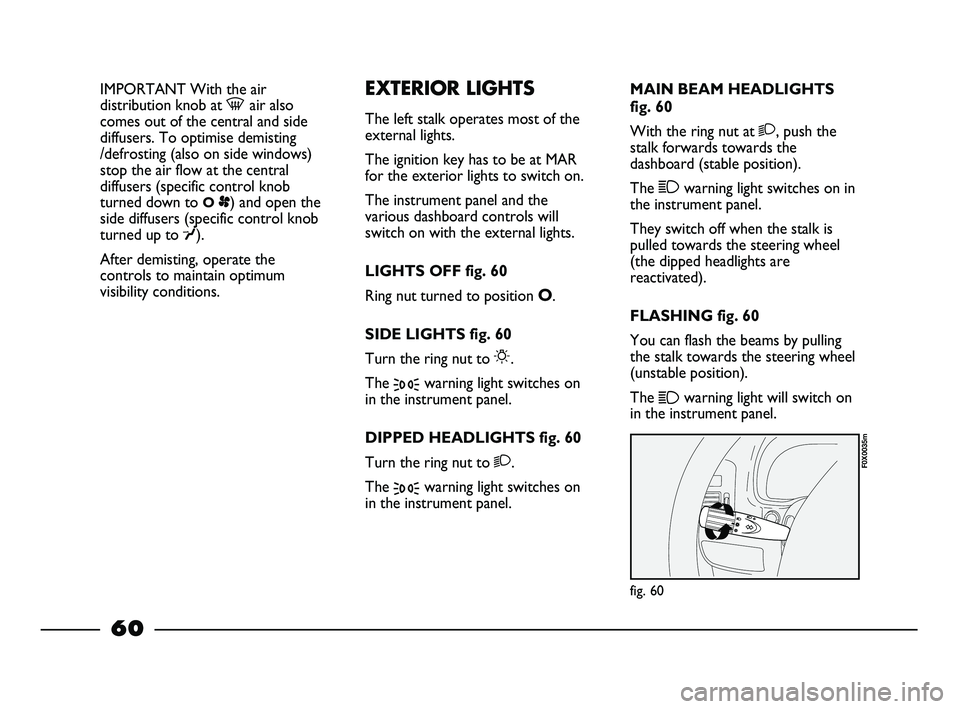
IMPORTANT With the air
distribution knob at -air also
comes out of the central and side
diffusers. To optimise demisting
/defrosting (also on side windows)
stop the air flow at the central
diffusers (specific control knob
turned down to
Op) and open the
side diffusers (specific control knob
turned up to
¥).
After demisting, operate the
controls to maintain optimum
visibility conditions.
EXTERIOR LIGHTS
The left stalk operates most of the
external lights.
The ignition key has to be at MAR
for the exterior lights to switch on.
The instrument panel and the
various dashboard controls will
switch on with the external lights.
LIGHTS OFF fig. 60
Ring nut turned to position
O.
SIDE LIGHTS fig. 60
Turn the ring nut to
6.
The
3warning light switches on
in the instrument panel.
DIPPED HEADLIGHTS fig. 60
Turn the ring nut to
2.
The
3warning light switches on
in the instrument panel.MAIN BEAM HEADLIGHTS
fig. 60
With the ring nut at
2, push the
stalk forwards towards the
dashboard (stable position).
The
1warning light switches on in
the instrument panel.
They switch off when the stalk is
pulled towards the steering wheel
(the dipped headlights are
reactivated).
FLASHING fig. 60
You can flash the beams by pulling
the stalk towards the steering wheel
(unstable position).
The
1warning light will switch on
in the instrument panel.
fig. 60
F0X0035m
60
045-094 STRADA LUM GB 1ed 23-01-2012 9:10 Pagina 60
Page 93 of 187
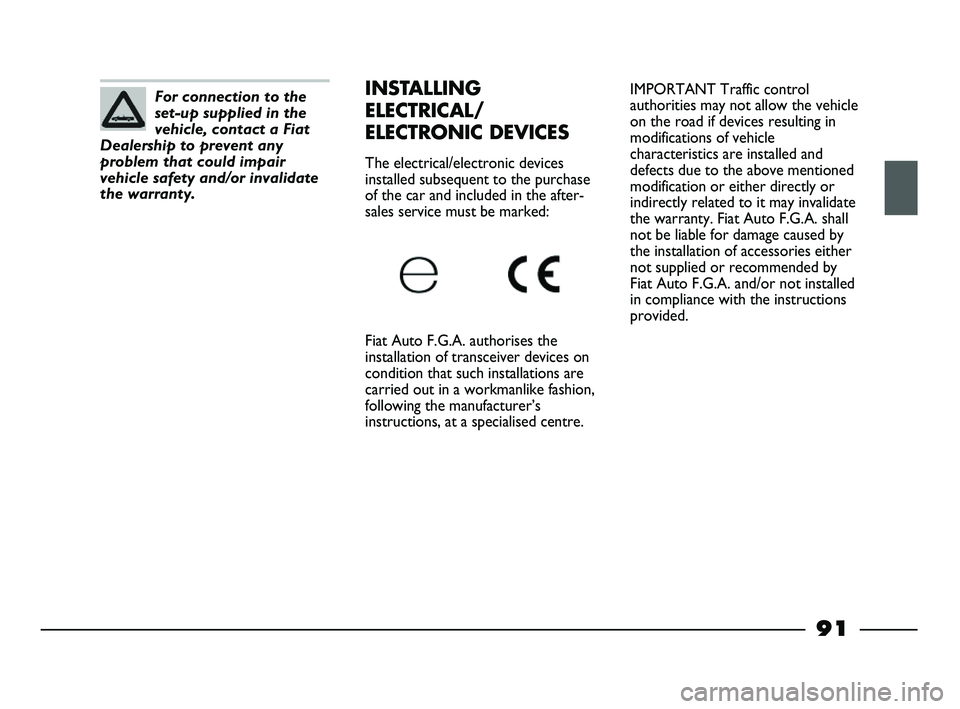
IMPORTANT Traffic control
authorities may not allow the vehicle
on the road if devices resulting in
modifications of vehicle
characteristics are installed and
defects due to the above mentioned
modification or either directly or
indirectly related to it may invalidate
the warranty. Fiat Auto F.G.A. shall
not be liable for damage caused by
the installation of accessories either
not supplied or recommended by
Fiat Auto F.G.A. and/or not installed
in compliance with the instructions
provided.For connection to the
set-up supplied in the
vehicle, contact a Fiat
Dealership to prevent any
problem that could impair
vehicle safety and/or invalidate
the warranty.INSTALLING
ELECTRICAL/
ELECTRONIC DEVICES
The electrical/electronic devices
installed subsequent to the purchase
of the car and included in the after-
sales service must be marked:
Fiat Auto F.G.A. authorises the
installation of transceiver devices on
condition that such installations are
carried out in a workmanlike fashion,
following the manufacturer’s
instructions, at a specialised centre.
91
045-094 STRADA LUM GB 1ed 23-01-2012 9:10 Pagina 91
Page 96 of 187
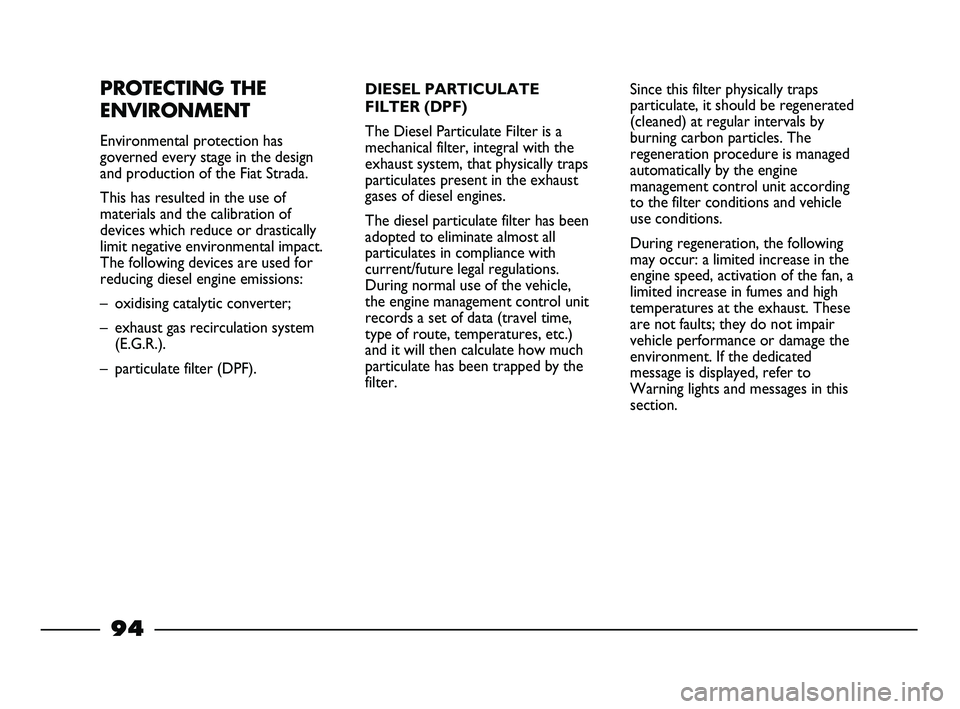
PROTECTING THE
ENVIRONMENT
Environmental protection has
governed every stage in the design
and production of the Fiat Strada.
This has resulted in the use of
materials and the calibration of
devices which reduce or drastically
limit negative environmental impact.
The following devices are used for
reducing diesel engine emissions:
– oxidising catalytic converter;
– exhaust gas recirculation system
(E.G.R.).
– particulate filter (DPF). Since this filter physically traps
particulate, it should be regenerated
(cleaned) at regular intervals by
burning carbon particles. The
regeneration procedure is managed
automatically by the engine
management control unit according
to the filter conditions and vehicle
use conditions.
During regeneration, the following
may occur: a limited increase in the
engine speed, activation of the fan, a
limited increase in fumes and high
temperatures at the exhaust. These
are not faults; they do not impair
vehicle performance or damage the
environment. If the dedicated
message is displayed, refer to
Warning lights and messages in this
section. DIESEL PARTICULATE
FILTER (DPF)
The Diesel Particulate Filter is a
mechanical filter, integral with the
exhaust system, that physically traps
particulates present in the exhaust
gases of diesel engines.
The diesel particulate filter has been
adopted to eliminate almost all
particulates in compliance with
current/future legal regulations.
During normal use of the vehicle,
the engine management control unit
records a set of data (travel time,
type of route, temperatures, etc.)
and it will then calculate how much
particulate has been trapped by the
filter.
94
045-094 STRADA LUM GB 1ed 23-01-2012 9:10 Pagina 94
Page 135 of 187
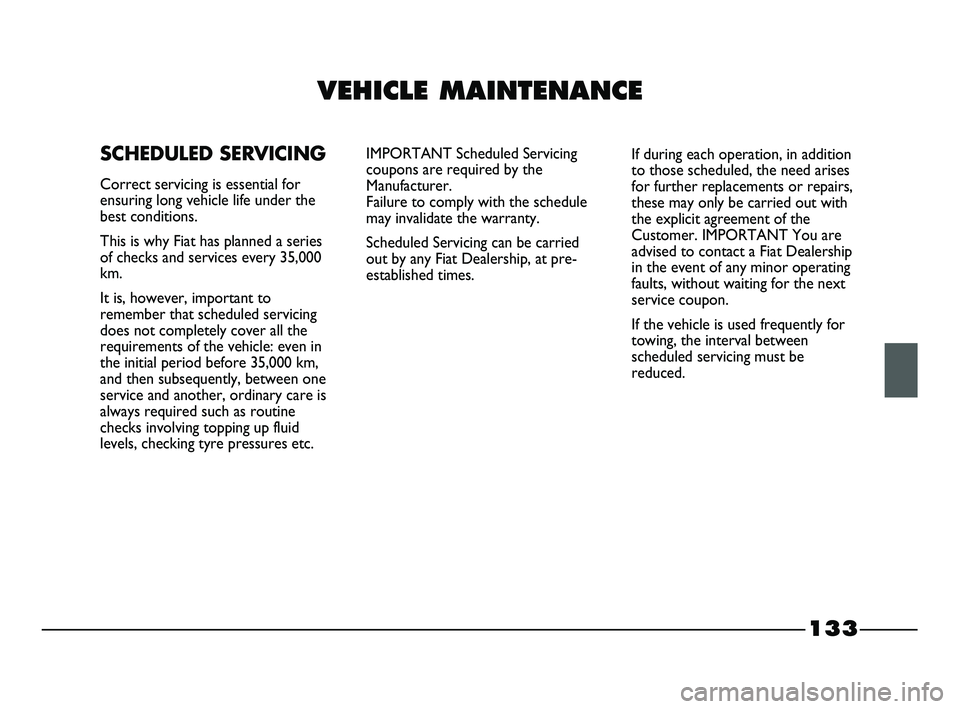
133
VEHICLE MAINTENANCE
SCHEDULED SERVICING
Correct servicing is essential for
ensuring long vehicle life under the
best conditions.
This is why Fiat has planned a series
of checks and services every 35,000
km.
It is, however, important to
remember that scheduled servicing
does not completely cover all the
requirements of the vehicle: even in
the initial period before 35,000 km,
and then subsequently, between one
service and another, ordinary care is
always required such as routine
checks involving topping up fluid
levels, checking tyre pressures etc.IMPORTANT Scheduled Servicing
coupons are required by the
Manufacturer.
Failure to comply with the schedule
may invalidate the warranty.
Scheduled Servicing can be carried
out by any Fiat Dealership, at pre-
established times.If during each operation, in addition
to those scheduled, the need arises
for further replacements or repairs,
these may only be carried out with
the explicit agreement of the
Customer. IMPORTANT You are
advised to contact a Fiat Dealership
in the event of any minor operating
faults, without waiting for the next
service coupon.
If the vehicle is used frequently for
towing, the interval between
scheduled servicing must be
reduced.
133-154 STRADA LUM GB 1ed 9-01-2012 14:53 Pagina 133
Page 137 of 187
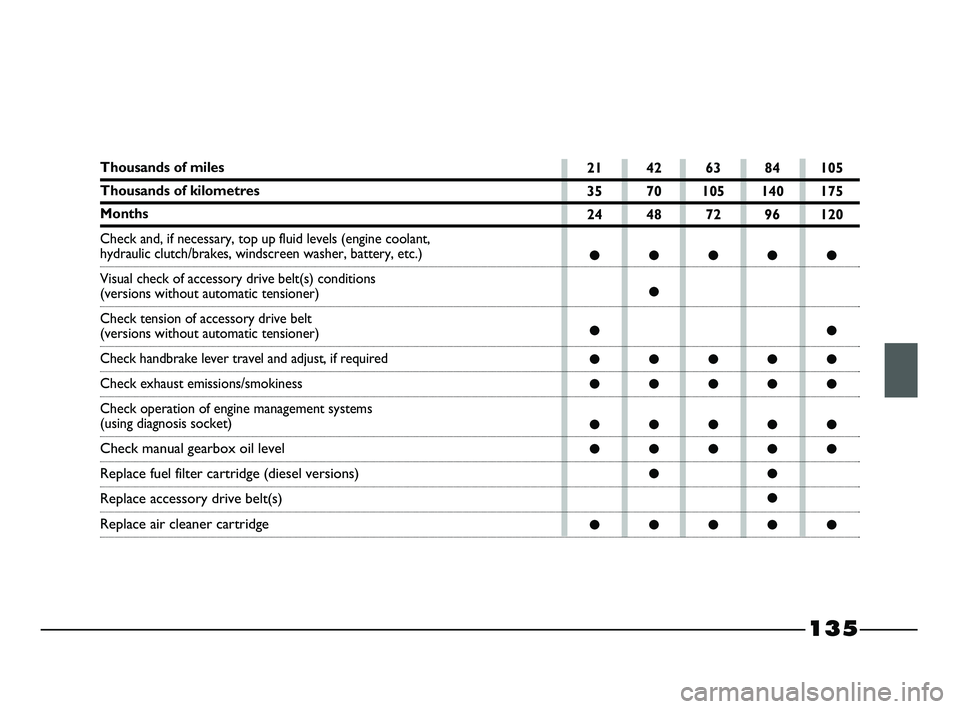
135
Thousands of miles
Thousands of kilometres
Months
Check and, if necessary, top up fluid levels (engine coolant,
hydraulic clutch/brakes, windscreen washer, battery, etc.)
Visual check of accessory drive belt(s) conditions
(versions without automatic tensioner)
Check tension of accessory drive belt
(versions without automatic tensioner)
Check handbrake lever travel and adjust, if required
Check exhaust emissions/smokiness
Check operation of engine management systems
(using diagnosis socket)
Check manual gearbox oil level
Replace fuel filter cartridge (diesel versions)
Replace accessory drive belt(s)
Replace air cleaner cartridge
21 42 63 84 105
35 70 105 140 175
24 48 72 96 120
●●●●●
●
●●
●●●●●
●●●●●
●●●●●
●●●●●
●●
●
●●●●●
133-154 STRADA LUM GB 1ed 9-01-2012 14:53 Pagina 135
Page 139 of 187
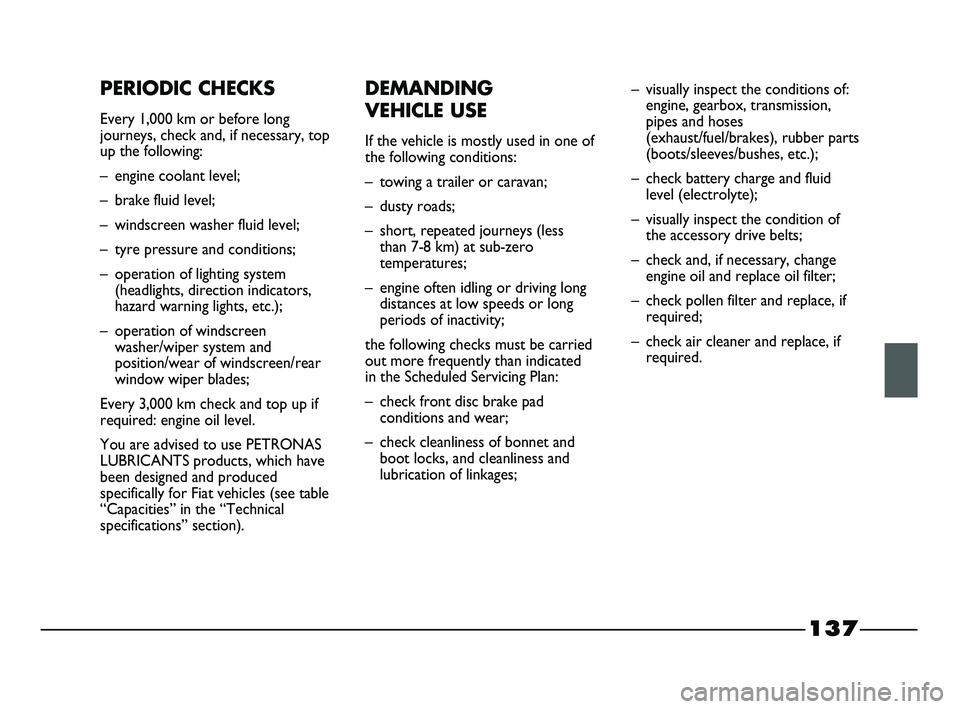
137
PERIODIC CHECKS
Every 1,000 km or before long
journeys, check and, if necessary, top
up the following:
– engine coolant level;
– brake fluid level;
– windscreen washer fluid level;
– tyre pressure and conditions;
– operation of lighting system
(headlights, direction indicators,
hazard warning lights, etc.);
– operation of windscreen
washer/wiper system and
position/wear of windscreen/rear
window wiper blades;
Every 3,000 km check and top up if
required: engine oil level.
You are advised to use PETRONAS
LUBRICANTS products, which have
been designed and produced
specifically for Fiat vehicles (see table
“Capacities” in the “Technical
specifications” section).
DEMANDING
VEHICLE USE
If the vehicle is mostly used in one of
the following conditions:
– towing a trailer or caravan;
– dusty roads;
– short, repeated journeys (less
than 7-8 km) at sub-zero
temperatures;
– engine often idling or driving long
distances at low speeds or long
periods of inactivity;
the following checks must be carried
out more frequently than indicated
in the Scheduled Servicing Plan:
– check front disc brake pad
conditions and wear;
– check cleanliness of bonnet and
boot locks, and cleanliness and
lubrication of linkages;– visually inspect the conditions of:
engine, gearbox, transmission,
pipes and hoses
(exhaust/fuel/brakes), rubber parts
(boots/sleeves/bushes, etc.);
– check battery charge and fluid
level (electrolyte);
– visually inspect the condition of
the accessory drive belts;
– check and, if necessary, change
engine oil and replace oil filter;
– check pollen filter and replace, if
required;
– check air cleaner and replace, if
required.
133-154 STRADA LUM GB 1ed 9-01-2012 14:53 Pagina 137
Page 152 of 187
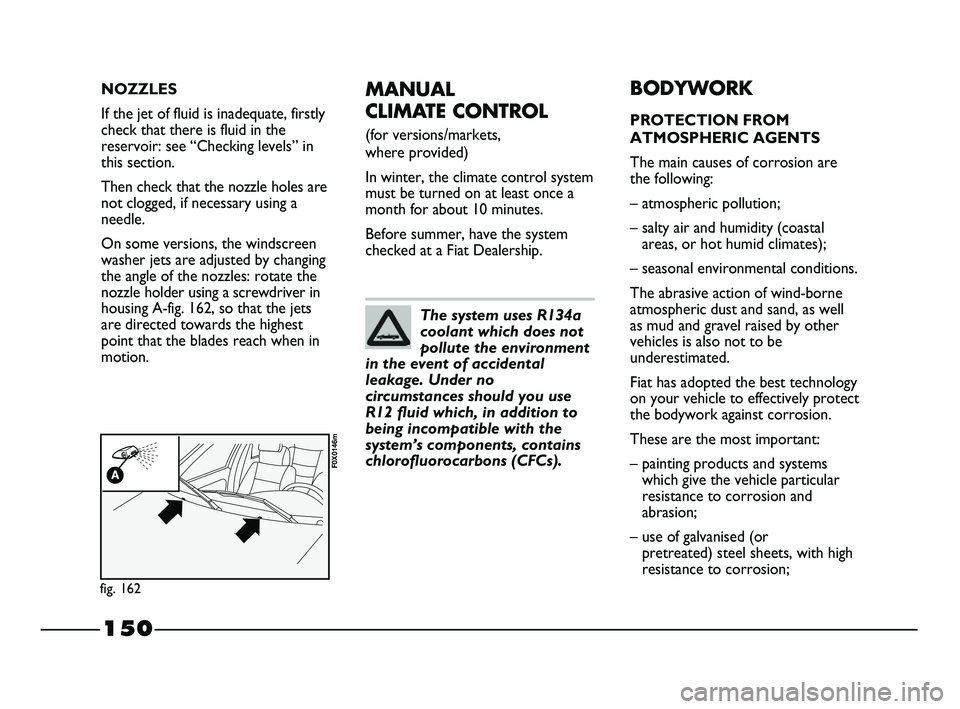
150
MANUAL
CLIMATE CONTROL
(for versions/markets,
where provided)
In winter, the climate control system
must be turned on at least once a
month for about 10 minutes.
Before summer, have the system
checked at a Fiat Dealership.
BODYWORK
PROTECTION FROM
ATMOSPHERIC AGENTS
The main causes of corrosion are
the following:
– atmospheric pollution;
– salty air and humidity (coastal
areas, or hot humid climates);
– seasonal environmental conditions.
The abrasive action of wind-borne
atmospheric dust and sand, as well
as mud and gravel raised by other
vehicles is also not to be
underestimated.
Fiat has adopted the best technology
on your vehicle to effectively protect
the bodywork against corrosion.
These are the most important:
– painting products and systems
which give the vehicle particular
resistance to corrosion and
abrasion;
– use of galvanised (or
pretreated) steel sheets, with high
resistance to corrosion;
The system uses R134a
coolant which does not
pollute the environment
in the event of accidental
leakage. Under no
circumstances should you use
R12 fluid which, in addition to
being incompatible with the
system’s components, contains
chlorofluorocarbons (CFCs).
NOZZLES
If the jet of fluid is inadequate, firstly
check that there is fluid in the
reservoir: see “Checking levels” in
this section.
Then check that the nozzle holes are
not clogged, if necessary using a
needle.
On some versions, the windscreen
washer jets are adjusted by changing
the angle of the nozzles: rotate the
nozzle holder using a screwdriver in
housing A-fig. 162, so that the jets
are directed towards the highest
point that the blades reach when in
motion.
fig. 162
F0X0146m
133-154 STRADA LUM GB 1ed 9-01-2012 14:53 Pagina 150